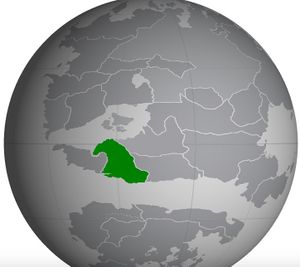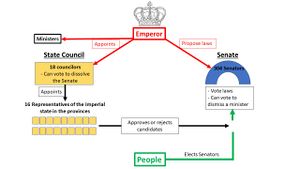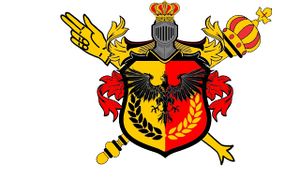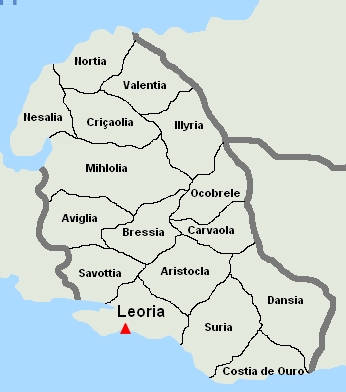Leorkhin
Empire of Leorkhin | |
|---|---|
Motto: O ferro salva o império (Iron saves the empire) | |
| Capital | Leoria |
| Official languages | Portuguese |
| Religion | 53.5% Catholic 46.1% Non-Religious 0.4% Other |
| Government | Unitary semi-constitutional monarchy |
• Emperor | Leopold I |
| Population | |
• Estimate | 32 million |
| GDP (nominal) | estimate |
• Total | 624 billions QBC₵ [4,555.2 billion Leorian reales] |
• Per capita | 19,500 QBC₵ [142,350 Leorian reales] |
| Gini (2023) | 38.3 medium |
| HDI (2023) | medium |
| Currency | Leorian reales (LRE) |
| Time zone | AMT-4 |
Leorkhin, officially the Empire of Leorkhin, is a medium-sized country located on the south Ecros continent. Leorkhin is bordered to the north east by New Illyricum and to the south east by Tyrandor. The country is divided into 16 administrative provinces, with a total population of 32 million. The political capital of Leorkhin is the coastal city of Leoria, while the economic capital is the city of Nesapolis, which is also the country's largest city. The Empire of Leorkhin is a unitary semi-constitutional monarchy ruled by Emperor Leopold I since January 5, 2011. Leorkhin is also a member of the CODECO, since the 5th January 2012.
Leorkhin is a nation that has seen its territory pass through the hands of various states and regimes throughout history. The first "Leorkhinian" state was the League of Southern City-States of Ecros. From this state sprang the legend of Leor the Unifier, who founded the city of Leoria and later gave the country its name. The League then became part of the Romanyan Empire until 531. Thereafter, the Despotat of Hispania was established as the second Leorkhinian state, until its conquest by the Muslims. Muslim occupation lasted until 876, when the Kingdom of Hispania was proclaimed. The Kingdom of Hispania reigned over a vast territory until its downfall, due to incessant wars of succession which split it in 1342 into 3 distinct states: the Grand Duchy of Nesalia, the Kingdom of Valentia and the Kingdom of Leorkhin. The era of the three kingdoms came to an end in 1762, when Leorkhin succeeded in uniting all the territories of the three kingdoms and proclaimed the Empire of Leorkhin.
Contents
- 1 Government
- 2 History
- 3 Economy
- 4 Military
- 5 Law and Order
- 6 Culture
- 7 Educational system
- 8 Geography, Topography, & Climate
Government
The Empire of Leorkhin is officially a constitutional monarchy, but this status has to be qualified. Since the ascension to the throne of Leopold I, the regime has gradually turned away from constitutionalism and taken the path of authoritharism and autocracy. The emperor wields power, and the limits to his power are becoming increasingly finer.
The empire's constitution establishes two main institutions: Council of State (inherited from the era of the Lord Protector) and the Senate, which holds legislative power. The Emperor holds executive power and certain judicial powers. While the powers may appear to be separate, the Emperor clearly has very powerful authority and can influence and control the Senate via Council of State. Therefore the monarch controls legislative power in addition to its broad executive powers.
The citizens have only a symbolic political weight. Citizenship is particularly restricted within the Empire, weakening representativeness and democracy. To be a citizen of the Empire, you must have Leorkhinian nationality, have reached the age of 20, be resident in the country, have professional status and not have been convicted of a crime (or misdemeanour before the age of 20). In 2023, there will be 19.6 million voters.
The Emperor
The full title of the Sovereign of Leorkhin is "His Imperial Majesty, Sovereign of the Leorkhinians, Protector of the Peace and Prosperity of the Empire". Succession to the imperial title has been by cognatic primogeniture with male preference since the era of the first Leorkhin kingdom.
The emperor is the key figure of the Leorkhinian regime, as laid down in the constitution. Unlike before the establishment of the constitution, the emperor is not considered to be God's representative on Earth (this had been decided to appease republican and communist demands), he is the representative of the nation, "approved by the grace of God", a nuance which was considered a humiliation for monarchists and nationalists.
The emperor is the head of state and head of government, appointing and dismissing ministers. He alone has the initiative to propose laws, which he promulgates if they are passed. He can also use edicts to promulgate tax laws without going through the Senate vote. The monarch of Leorkhin is also the head of the Empire's Armies, appointing the general staff. He directly appoints the members of the Council of State, the empire's second key institution. The emperor is also responsible for diplomacy.
The emperor has two judicial powers: the power of pardon and the power of condemnation. The power of pardon allows the sovereign to overturn any sentence passed by the imperial court after it has been pronounced. A majority vote in the Senate can overturn the granting of a pardon. The power of condemnation allows the emperor to transform any prison sentence exceeding 25 years into a death sentence; this can also be revoked by a vote in the Senate.
The imperial family coat of arms represents the symbols of imperial power. The imperial crown symbolises the emperor's power. On the shield, the eagle, the national symbol of the empire, is surrounded by the laurel wreath, representing power since the time of the Romanyan Empire. At the back, the hand of justice is a reminder of the justice of the empire, of which the emperor is the guarantor. The sceptre has always been the object of power for Leorkhinian sovereigns. As for the colours, gold embodies the wealth of the country, red the blood shed for the survival of the empire, while black is the colour of the imperial eagle.
The Senate
The Senate was the empire's legislative body and was the first institution to be created to limit the powers of the sovereign. The Senate is made up of 304 senators, elected in each of the empire's 16 provinces (in 19 constituencies for each province). The Senate passes laws proposed by the emperor and constitutional amendments by an absolute majority. The Constitution can be abolished if proposed by the emperor and approved by a 2/3 majority. The senators can also vote to force the resignation of a minister appointed by the Emperor.
Senators are elected by direct universal suffrage in 2 rounds by the citizens of their constituencies. In order to stand for election to the Senate, candidates must have been citizens for at least 5 years and must have their candidacy approved by the imperial state representative in the provinces (appointed by the Council of State).
On taking office, senators swear an oath to the emperor. The Senate can be dissolved by a vote of the Council of State. In this case new elections must be held within 20 days of the dissolution, during which time no laws may be enacted and the constitution may not be amended.
In 2023, the Senate is largely dominated by the Imperial Renaissance Party, the party supporting Emperor Leopold and his authoritarian policies. The party holds 268 of the 304 senatorial seats.
The Council of State
The Council of State or State Council is one of Leorkhin's key institutions. It is made up of 18 members appointed by the Emperor. Officially, their role is to assist the emperor in the exercise of his power, but in practice the state councillors serve the monarch to help him consolidate his authority. Created during the era of the Lord Protector, their authority has since been greatly diminished.
The Council of State has the power to vote for the dissolution of the Senate. In addition, the Council of State appoints the representatives of the imperial state in the provinces, which approves or rejects the candidacies for the senates in each constituency.
Prior to the ascension of Emperor Leopold I to the throne, the Council of State was appointed by the Imperial Chancellor, who in turn was appointed by the Emperor, making the Chancellor one of the most powerful figures in the country. But in his desire to concentrate power, Leopold I orchestrated the "Cardoso affair" countering the powerful chancellor appointed by his predecessor to resign and taking advantage of this to have the post supressed by referendum. From this event the emperor directly appointed the members of the Council of State.
History
Ancient times
Foundation
The first signs of civilization on the territory of present-day Leorkhin are diverse and still subject to archaeological research. Today, the scientific community agrees that the first peoples came to settle in Leorkhin in search of fertile land or perhaps fish-rich waters.
These peoples of very diverse origins formed the first tribes of Leorkhin. The expansion of these tribes was largely due to the fertile soils of central Leorkhin and the numerous exchanges that took place between them. In fact, the discovery of ancient drawings depicting large caravans of goods has enabled researchers to establish that highly-developed forms of trade were already in place very early on (around 3000 BC).
-1200 to -464
Over the centuries, tribes formed city-states throughout the Leorkhinian territory. Contrary to popular belief, these city-states lived in lasting peace, thanks to the immense profits (in resources and later in gold) generated by trade, from which their leaders profited handsomely. Conflicts between cities were extremely rare, and no regional grouping succeeded in imposing itself (between 1200 and 500 BC).
A tacit agreement between cities ensured prosperity for all. From 600 BC onwards, this agreement became official with the emergence of the League of Princes (as it is known to scientists today), a military and economic alliance between the various city-states, with the aim of preventing disruption to trade. According to early ancient historians, the League was "the ideal of peace and prosperity, on the road to happiness for all". In actual fact, the League, although it helped to avert certain conflicts between member princes, served above all to collectively quell revolts (notably slave revolts). What's more, while in principle all princes were equal members of the League, the latter did fail to offer assistance when a city was in dire financial straits. Even so, the stability of the territory was assured.
This status quo lasted for almost a century, until the city of Nesapolis gained a considerable foothold over the other League cities. Nesapolis was founded around 1100 B.C. by various peoples from the northern shores of present-day Leorkhin, and was a coastal city with a vast harbor and docks equipped to handle a wide range of goods. By 503 B.C., Nesapolis had become by far the largest city in the League. thanks in particular to the establishment of overseas trading posts and embassies in numerous kingdoms and foreign countries. These relationships enabled the city to introduce new goods and bring in many cargoes of slaves, purchased after wars in distant lands.
The prince of Nesapolis in 503 B.C. was a certain Leor. First elected by his peers on the city's council of merchants, he set about unifying the League's cities politically to form, according to these memoirs (the veracity of which is more than disputed today, it would appear to have been written around the first century), "a giant of gold and precious stones such as the maps of this world have never seen". Although Nesapolis was so rich, it could not stand up militarily to the League.
Romanyan Era (-464-531)
Post-Romanyan Era (531-1342)
Late medieval and early modern times (1342-1503)
The Era of Fragmentation (1503-1762)
First Empire of Leorkhin (1762-1981)
Proclamation of the empire (1762)
Turbulent times during the reign of Augusto III (1892-1898)
At the start of Augusto III's reign, the young sovereign had to deal with a complicated domestic situation inherited from his predecessors. Unable to maintain order with the same authority as his absolutist father Felipe I, Augusto III was overwhelmed by protests. The previous emperor's champion, the minister and general Octavio Lambes, rallied the conservative and reactionary upper echelons of power and fomented a palace revolution against the emperor.
Lambes marched on the capital with the imperial army and, with the support of the Action Faction (a group of ministers, statesmen and military men, formerly forming Felipe I's inner circle), imposed a dictatorial regime on Augusto III. Octavio Lambes became Minister-General of the Empire, holding de facto full powers and taking Leorkhin into King Augusto's war. The dictator was defeated militarily by New Illyricum, and his regime fell with him.
Leoria's Revolution (1907)
Era of the Lord Protector (1928-1981)
From 1928 to 1979, the Empire of Leorkhin was subject to the establishment of a totalitarian regime, led by Alejandro Macedo. This period was known as the Era of the Lord Protector.
Second Empire of Leorkhin (1981-)
Economy
Although Leorkhin once boasted remarkable prosperity due to its extensive trade, today the empire's wealth is rather limited. The country now boasts a GDP of 624 billion QBC credits (a rather fragile statistic for a country of its size) and a per capita GDP of 19,500 QBC credits (a fairly average number).
Leorkhin's currency is the Leorian Reales, controlled by the Imperial Bank of Leorkhin. In 2023, the Leorian Reales is worth 7.3 Quebecshire credits. The governor of the Imperial Bank is appointed directly by the emperor.
Leorkhin has a market economy, with certain "strategic sectors" nationalized. State intervention in the economy remains very important, particularly since the introduction, in May 2018, by imperial decree of the National Business Council. The purpose of this council is to control companies and check that they are acting in the national interest. To this end, the Council has the power to replace the board of directors of any Leorkhinian company with new members. However, this measure remains extremely rare, but enables the regime to ensure the loyalty of contractors or, if not, to get rid of them.
The country's wealth is very unevenly distributed, with a Gini coefficient of 38.3. This is due to the emergence of an oligarchic caste since the early 1980s, following the end of the Lord Protector regime. Emperor Felipe II needed support to fight against the Macedo loyalists, who were still present in large numbers in the political landscape and the army, and relied on very small groups of personalities attracted by the lure of gain. Powerful conglomerates and great wealth were assembled, strengthening the power of the Emperor's "friends" and thus diminishing the influence of the Lord Protector's remaining supporters. Today, Emperor Leopold I has made the fight against corruption and oligarchs one of the major causes of his regime (In line with his goal of centralizing power).
Leorkhin's wealth is largely based on international exports of manufactured goods and raw materials. The country's many coastlines enable it to develop a significant maritime trade. The Empire's main raw materials are copper and coal. For industry, the country relies on its heavy industries and shipyards.
Government budget
Leorkhinian state budget in percent
Every year, the Leokhinian state distributes its budget and submits it to the Senate for a vote. The numerous expenditures reflect the objectives of the current sovereign. Indeed, the biggest expenses are in education and health, reflecting the quest for productivity in the economy (by innovating and creating more skilled workers) as well as a desire to increase the country's HDI.
Defense spending comes third, having exceeded 10% of the budget since 2013. This is part of the modernization and remilitarization process initiated by Emperor Leopold I. The introduction of compulsory military service has also contributed to the increase in the military budget.
With massive government investment and the economic slowdown during the reign of Charles II, the Empire's debt had grown. Leorkhinian debt reached its peak as a percentage of GDP (94%) in 2009. Since Leopold I's accession to the throne, public revenues have been boosted by tax reforms, increased controls and political control of the economy. As a result, debt has been reduced to 57% of GDP by 2023.
With the rise of authoritarianism, surveillance and security policy in the face of terrorism, the budget for justice and security services has exceeded 10% of the budget. The budget allocated to the secret services (ISSO) remains secret, however, as the state does not wish to show the extent of the resources made available for espionage and counter-espionage.
Research and higher education only come in 6th place, which contrasts with the top position held by "classical" education. This sector has been rather neglected to the detriment of importing foreign technologies, although it is gradually being upgraded. For imperial economic theorists, innovation is sidelined in favor of increasing fixed capital and labor power.
Ecology and sustainable development remain a very secondary objective for Leorkhin. The modernization of the economy and rapid growth imply industrialization and a certain flexibility in environmental regulations. As the budget is so small, it is grouped together with agriculture so that it can carry weight.
Military
The armed forces of Leorkhin are composed of nearly 260,000 professional soldiers, divided into three branches: The Imperial army, which is all the conventional land forces, the Imperial navy grouping together the naval and naval air forces and the last branch being the 'Imperial Air Force. Leorkhin can also count on nearly 400,000 reservists and conscripts to fill its ranks.
The army has always played an important role in the history of the empire and in the assertion of imperial power. During the era of the Lord Protector, she was subject to many purges, diminishing her military abilities but ensuring her loyalty to the ruler. After the death of the Lord Protector, the imperial army tried to carry out a coup d'etat to prolong the emergency regime, but failed due to the unpopularity of the putschists and the hesitations of the military command. During the Restoration, elements loyal to the Lord Protector were eliminated during the "purge of slaves". This put a definitive end to the political role of the army.
Since the beginning of the reign of Leopold I, the military budget kept increasing and the size of the armed forces was increased considerably. The establishment of compulsory military service of 12 to 48 months for men and women confirms the militarist turn taken by the Leopoldian regime.
Law and Order
Police
Leorkhin goes to great lengths to maintain law and order. In addition to its role as defender of the peace, the police also play a repressive role in hunting down and arresting the empire's opponents and dissidents.
The Leorkhinian National Police employs some 170,000 people throughout the empire. It reports to the Ministry of the Interior, whose Minister is appointed by the Emperor.
Secret Police
Leorkhin also has a secret state police force, the Imperial State Security Office, which serves both as a counter-espionage body and a political police force. Its role is to track down enemies of the imperial state and arrest them discreetly. The ISSO is accused of handing down summary judgments behind closed doors, and of removing dissident elements from the country's political landscape (using methods that run counter to human rights). However, the use of assassination has almost disappeared nowadays.
Justice
Leorkhin is rather conservative in its thinking, and does not hesitate to legislate in order to multiply prohibitions. Capital punishment is still in force in the empire, as insrcited in the constitution: "In its mission to ensure the common good and the preservation of peace, it is the sacred mission of the state to execute the most dangerous elements of society, so that none need take justice into their own hands". However, its use remains fairly limited, with only 84 executions in 2023.
Drugs
The Leorkhin civil code thus prohibits the consumption and the production of narcotics of any kind. The state draws up a list of all the drugs listed, but the sentences handed down do not take into account the type of drug consumed or produced. Penalties for production range from a minimum of 8 years' imprisonment to the death penalty for the biggest networks.
Culture
Educational system
Geography, Topography, & Climate
The Empire of Leorkhin is divided administratively into 16 provinces. The capital province is Leoria, home to the empire's capital (of the same name). Each province is divided into 16 constituencies, each of which elects a senator to represent them in Leorkhin's unicameral parliament: the Senate.
The southern provinces, which are open to world trade, are the richest (behind Nesalia) and rely heavily on trade. The exception to this is Costa Oura Shipyards, Leorkhin's largest shipbuilding company, whose shipyards are located mainly in the Costia de Ouro and Suria regions.
The northern provinces of Nortia, Nesalia and Valentia are also particularly wealthy (especially Nesalia, which is the richest region in the country), but come just behind the south.
The western provinces (Cirçaolia, Mihlolia, Aviglia and northern Savottia) are mainly agricultural, and are the poorest and least populated in the Empire. Aristocla, although geographically part of the South, is in a similar situation.
The eastern and central provinces (Bressia, Illyria, Ocobrele, Carvaola) are the industrial heartland of the empire, producing both manufactured goods and natural resources. Dansia can also be added to this category, although it lies further south.





